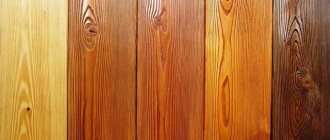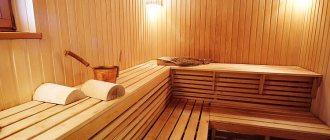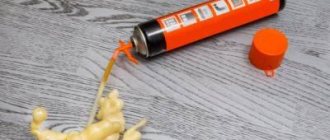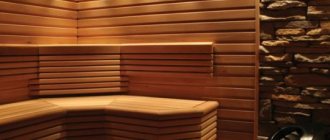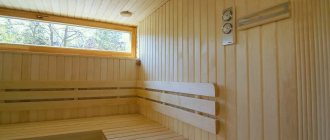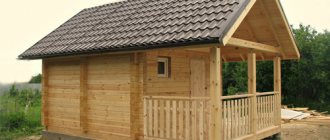The most popular finishing material for a bathhouse is lining; it is made from aspen, alder, pine, and linden boards are often used. This type of cladding is characterized by high performance characteristics: strength, resistance to moisture, steam, and temperature changes.
In order for the wood used to last as long as possible, it must be coated with special compounds that protect against the formation of rot and deformation.
Criterias of choice
For all its advantages, wood is susceptible to moisture. Over time, it dries out, darkens and begins to rot. Mold and microorganisms may appear on it. All this is true for normal external conditions. And in the steam room the conditions are extreme. Even in the dressing room there are no such impacts on the walls and floor. The influence of sudden changes in temperature and humidity in the steam room accelerates the destruction of wood. When exposed to high temperatures, conventional protective coatings can release harmful substances.
In addition, a steam room is not just a room in which a person is located. He remains there naked, his body in contact with wooden surfaces. And on some it even lies. This means that for shelves and benches you need to choose wood protection that will not be unpleasant upon contact.
Most often in the steam room they try to preserve the natural color of the wood, selecting species that look beautiful. But if you want to paint part of the steam room, then you need to take this into account when choosing an impregnation. Not every impregnation is suitable for subsequent painting.
Wood color after different impregnations Source elka-palka.ru
It is clear that it will not be possible to find the same impregnation for a bathhouse outside and inside. Even different parts of the steam room may require different protective equipment. Wood treatment in a steam room should be carried out with compounds adapted to its conditions. And the choice must be based on the following criteria:
- Which part of the steam room is the product intended for?
- Will it be primary impregnation of wood, or re-coating of a previously protected surface?
- Method of applying a protective substance to a wooden surface - with a brush, roller or spray
- Are there plans to further paint the impregnated wood?
Fire retardants
Treating a bathhouse made of timber using fire retardants must be carried out without fail, because this building has a high probability of a sudden fire. For fire protection of the external walls of the bathhouse, you can use the compositions Neomid 450-1 and Prosept Ognebio Prof1. They are well absorbed into the wooden material, but when exposed to high temperatures they protrude out, creating a barrier between the flame and the wood. And also preventing access of oxygen to the wood and protecting it from fire. After applying the composition, the timber walls of the bathhouse will acquire the highest degree of protection from fire. In addition, they will be additionally protected from biological pests of wood, thanks to the antiseptic components included in their composition.
Ceiling
Perhaps the least requirements are placed on this part of the steam room. It is exposed only to the temperature effects of steam. Water almost never reaches it. Therefore, it can simply be coated with a specialized bath varnish.
The ceiling in the bathhouse must be reliably protected from dampness and temperature Source eco-ceiling.ru
See also: Catalog of companies that specialize in paints and varnishes.
Floor
Unlike the ceiling, all the water that is used in the steam room ends up on the floor. Therefore, the anti-water protection for floor boards must be very good. In addition to antibacterial and anti-water impregnation, it is advisable to cover the floor with a protective layer of varnish. But not every varnish is suitable for the floor. The protective layer should not be slippery. This is a must to protect the floor. Of course, the soles of your feet should not stick to the floor. Do not think that repeatedly coating the floor with varnish increases its safety. The thick layer of varnish cracks and water reaches the wood. In addition, the wood cannot “breathe” through such a coating and will still deteriorate.
When building a bathhouse, do not forget about impregnating the logs on which the floor boards are laid. This, of course, is not the inside of the bathhouse, and there are no special protection requirements for them. But if water gets to them, then sooner or later the floor inside the bathhouse itself will suffer, no matter how well it is protected.
Walls
Most of the impregnation for the bathhouse inside is spent on protecting the lining, which is usually used to line the walls. Therefore, you should not use impregnations and varnishes that, when heated, can release strong-smelling substances. And do not cover it with a protective layer that does not allow the wood to “breathe.”
Improper use of protective compounds can lead to the regular appearance of condensation on the walls of the bath Source synteko.in.ua
Shelves and benches
The shelves are the main part of the entire steam room, for which it is, in fact, built. Lying on it should be comfortable, pleasant and safe for health. Wood is a poor heat conductor, so even at high temperatures you won’t get burned by it. It’s another matter if it is covered with a protective film, which can cause a burn if touched. Therefore, it is not recommended to use paints or varnishes for it. It is better to apply a special impregnation for the bath. Often such impregnations are wax-based.
The requirements for the safety and convenience of the surface of shelves and benches are so high that there are bathhouse lovers who believe that wood should be natural for them and not covered with anything at all. But this is still suitable for small bathhouses, where simple shelves can be replaced. And when real furniture masterpieces are built, it is better to find a high-quality composition and ensure their durability.
It’s not enough to create beauty – you also need to protect it Source m.yukle.mobi
Floor protection
Wood is traditionally used for flooring. The organic substances contained in the material make it less resistant to various negative factors. This can be minimized using special compounds.
The design of the floor requires the presence of logs. Due to their location, they are protected from direct sunlight, temperature changes, and direct contact with water. But saunas are areas of high humidity. Therefore, condensation, capillary moisture, living organisms are factors that negatively affect logs.
Bathroom floor design
When a bathhouse is treated, building codes define two types of measures aimed at protecting wooden elements.
Structural protection
Proper arrangement of the underground space is the key to preventing the board from rotting due to condensation. In particular, it involves ventilation equipment between the flooring and the joists. Mechanical hydraulic protection is also used for protection. It involves the use of gaskets made from bitumen-containing films.
Chemical protection
Impregnation of floor beams has antibacterial value. It is best to treat joists with water-washable compounds, since these parts are not directly exposed to precipitation or regular washing (especially with aggressive agents). Biological protection of log baths and saunas is carried out with an antiseptic, which is based on linseed oil, a solution of wood resin, copper salts, and urea. Treatment with beeswax also gives good results. These compounds, in combination with properly done ventilation, protect the joists from rotting.
It should be remembered that it is better to warm up oil compositions before application.
It is important to remember that covering the boards in a bathhouse with machine sanding is not the best solution. Excessively high chemical activity is not suitable for the constant humidity of a sauna.
Traditionally, sauna logs are recommended to be treated with solutions containing borax, silicate glue, potassium dichromate, and vinegar. Today there are compositions on sale that can be called an antiseptic with broad functions:
- protection from damage by living organisms;
- giving wood fire-resistant qualities.
The compositions used to treat bath or sauna logs should not lead to significant shrinkage of the wooden elements. At the same time, maximally closing the pores of the ends of the boards is their main task. Factory mixtures are applied exclusively in a cold manner in several layers. After the impregnation has completely dried, the wood should be coated with polymer paints.
Protective compounds and their properties
For the sake of order, it is necessary to mention such a remedy as drying oil, which used to cover all the insides in the bathhouse. It is still used today, but it should not be used in a steam room. It will be cheap, but cheerful. In terms of protective properties, this is yesterday, and the smell from it when heated well is not pleasant.
Water-dispersed impregnations
They are made on a water basis, so they penetrate deeply into the wood structure. They are resistant to high temperatures, do not contain active chemical components and do not emit any harmful compounds when heated. Modern water impregnations contain antibacterial components. Available both colorless and with added dyes.
The disadvantage is their fragility. Over time, under the influence of water, they are washed out of the wood, so the impregnation must be renewed every two years.
Oil impregnations and varnishes
They impregnate and protect wood well from moisture, forming a film. But their inherent smell is a significant drawback. Therefore, they must be used with caution in the steam room. They are quite suitable for external impregnation and for protecting wood in the dressing room.
The varnish preserves the appearance of the wood, giving it a mysterious shine Source freepatriot.club
Acrylic based varnishes
Acrylic varnish for baths inside is considered safe. A modern product made from polyacrylates and organic solvents. Environmentally friendly and more durable than conventional water-dispersed products. Acrylic varnishes produced for baths and saunas necessarily contain antifungal components.
Water-based polyurethane varnish
Combines the advantages of water-dispersed and alkyd varnishes. It appeared on the market relatively recently, so it should be treated with caution, as with any new product. And its price is quite high.
Wax-based impregnations
Wax, like drying oil, has long been used to protect and add shine to wooden surfaces. Nowadays purely wax impregnations are almost never used. It is common practice to add wax to protective products based on other components.
In addition to protective products, special detergents are also produced for cleaning and bleaching wood. They are used both before applying protection and for washing dirty and darkened surfaces.
How to treat bath shelves
Bath shelves are the place where your body will directly touch the wood, so you can treat bath shelves with the best natural impregnations. In most cases, they are made from vegetable oils and wax.
— In order to treat the bath shelves in the steam room, you can buy SATU for the shelves, this is a colorless protective oil that is absolutely harmless to the body. On sale 0.25 liters, cost 400 rubles. The shelves are treated with this oil in one or two layers according to the instructions. Other manufacturers also have similar oils for shelves - TEKNOS Sauna NATURA oil, etc. But the German company Biofa produces liquid wax, which is also very suitable for treating shelves in a steam room. A 0.2 liter jar will cost 1100 rubles, consumption 70 sq.m. per liter
Protective products for baths from different manufacturers
When processing wood inside a steam room, you should not experiment too much. You need to choose varnishes and impregnations made specifically for baths and saunas. Those who produce such products take into account the conditions and requirements for such premises.
The Finnish company Tikkurila is considered the leader of such products.
- Supi Saunasuoja – water-based impregnation with acrylic. Suitable for temperatures above 100 °C. A universal product for internal protection of steam rooms. Available in both a colorless version and a form suitable for tinting.
Impregnation Supi Saunasuoja Source marketut.ru
- Supi Laudesuoja – oil impregnation suitable for covering shelves
- Supi Saunavaha is a wax-based varnish. It is also considered universal and suitable for any bath surfaces.
Imported compounds have one drawback - the price. Domestic manufacturers provide cheaper products. Here are some designed specifically for bath conditions:
- Senezh sauna is an acrylate-based antiseptic to protect wood in saunas. Contains antimicrobial agents but is odorless.
- NEOMID 200 – antiseptic for wooden bath surfaces, including shelves and benches.
- NEOMID Sauna is a translucent acrylic-based varnish. For protecting and finishing wood in rooms with high humidity.
NEOMID Sauna varnish for baths Source gros-stroi.ru
Processing inside: how to process - methods and technologies
How to treat a bathhouse with an antiseptic? There are three methods (minimum) suitable for these purposes. They will differ in the depth of impregnation. Well, let’s describe the fourth, the best, but requiring industrial equipment.
The simplest and most accessible method for everyone is to apply the solution to the surface of the wood using a roller or brush, or if you have one, use a spray bottle. This is done several times as the previous layer dries. The number of layers is usually specified by the manufacturer in the instructions. The penetration depth of the antiseptic is minimal - up to 5 mm, but more often 2-3.
Antiseptic (impregnated) edged board, pine. Photo Pilomaterialy.rf
The second method gives a slightly greater depth of impregnation and at the same time requires some equipment. For prepared (cleaned to wood) lumber, a “bath” is made - for example, it can be dug in the ground in the form of a trench of the required length and covered with polyethylene.
An antiseptic solution is poured into the bath, and the lumber is completely immersed in it for several days. The number of days depends partly on the type of wood. Let's say that spruce always needs more time to soak than pine.
The third method can also somehow be implemented on the site. To impregnate boards, for example, sand is soaked in antiseptic, and then stacks of prepared boards are layered with this sand. The stack of sand is covered with films and left for a couple of weeks. It is assumed that the film will protect the antiseptic from evaporation, and the wood will absorb it through osmosis.
The fourth method is beyond the capabilities of the owner of the site (for independent implementation). is already needed here . This is an industrial impregnation, which is called impregnation. The deepest, most effective. Lumber impregnated with a suitable antiseptic is sold everywhere, they are green or brown, a good manufacturer uses a product from Britain called “Tanalit” - it does not work only against one class of house rot - basidiomycetes, it resists everything else well.
Care Tips
In order for a bathhouse to serve its owners for many years and decades, it is necessary to adhere to certain rules. Some of them are common to any building:
- maintaining cleanliness and order;
- timely restoration of paintwork;
- necessary routine repairs.
The other has a specific “bath” character:
- ventilation and drying of the steam room after use;
- timely culling and replacement of stones in the heater;
- cleaning the stove and chimney from soot.
The last point can be implemented “with your own hands” without inviting a professional chimney sweep. In order to use the bathhouse for its intended purpose, it is enough to heat the stove with aspen wood during the breaks between fires. According to experts, aspen firewood perfectly cleans the stove and chimney of soot deposits.
Why is impregnation of wooden walls necessary?
Special attention should be paid to the arrangement of an object such as a bathhouse or steam room. The room must be resistant to high humidity and temperature changes. Traditionally, deciduous trees are used for the construction of baths, as they have a number of advantages:
- low thermal conductivity;
- environmental friendliness;
- beautiful appearance;
- nice atmosphere.
To improve your health and find peace of mind, you need a pleasant atmosphere close to natural conditions. Natural wood has everything necessary and gives a person its energy, natural warmth, and health. Wood is superior in its technical characteristics to many modern materials. The only drawback of natural material is that it cannot retain its natural qualities for a long time without special processing.
In the old days, people used simple means for processing - oil or wax . Of the inexpensive oils, we used sunflower oil without a specific odor. More expensive oils were also used - anise, lavender, rose. Some expensive oils were added to refined oil and a richer and more pleasant smell was obtained.
Wood is highly hygroscopic, so it quickly absorbs moisture. Loose wood tissue becomes a favorable environment for the penetration of microorganisms. A number of insects can immediately settle in such an environment. They spread quickly and destroy the structure of the tree. At a normal level of humidity in wood, tannins and resins will serve as reliable protection against various insects and fungal infections. Even under such conditions, the wood must be impregnated with special agents. At high humidity, a wooden structure will be constantly exposed to:
- mold;
- parasite damage;
- rotting.
If you use special antiseptic drugs, then the risk of bacterial infection is reduced. The internal surface of the bathhouse receives protection from various types of wood-destroying parasites.
For concrete
It’s easier with concrete than with oven bricks. Concrete is not associated with high temperatures; it is most often protected from destruction under the influence of water.
For this purpose, water-repellent impregnations can be used. There are quite a lot of them, they provide the formation of a layer on the surface that prevents it from being wetted by water.
In addition, there is a whole range of impregnations designed not only to make the surface waterproof, but also to increase the strength and other characteristics of concrete . It’s unlikely that all of them can be useful in a bathhouse, but it’s worth listing them:
- Polyurethane impregnation for concrete in a bathhouse is an acceptable option, not too expensive. Layer depth up to 4 mm.
- Deep penetration impregnation - provides very high strength to concrete bases, but it is not necessary for a bathhouse.
- Epoxy impregnation is two-part, odorless, forms a layer of 1-2 mm.
- Acrylic is a cheap option, suitable for lightly loaded concrete surfaces.
- Fluate impregnation - eliminates efflorescence because it binds free calcium inside concrete and brick. We also don’t see much use for it in the bathhouse, if we are talking about concrete.
In general, for a concrete floor, a water repellent or polyurethane impregnation will do; for a drain under the floor, a water repellent is sufficient, because there is no load on it at all.
